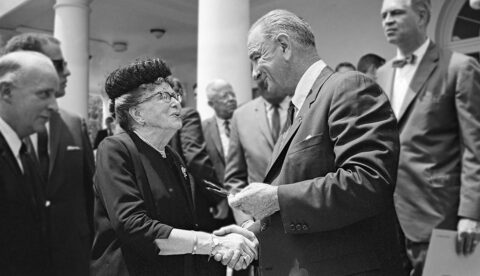Home-delivered meals, in-home care, and senior centers are just three of the many community-based services designed to help us live comfortably as we age. As we reach the conclusion of Older Americans Month, we’re revisiting the groundbreaking legislation that laid the foundation for these and other support systems for older adults.
From proclamation to legislation
In 1963, President John F. Kennedy proclaimed May as Senior Citizens Month to focus attention on the 17 million Americans who were turning 65 that year and the roughly one-third of older citizens who were living in poverty.
Building on President Kennedy’s vision, President Lyndon B. Johnson signed the Older Americans Act (OAA) into law in 1965, as part of his Great Society initiatives, and declared May as Older Americans Month. The goal was to create programs and services that would enable older adults to age with dignity and independence.
At the signing ceremony on July 14, 1965, President Johnson remarked: “The Older Americans Act clearly affirms our nation’s sense of responsibility toward the well-being of all of our older citizens. But even more, the results of this act will help us to expand our opportunities for enriching the lives of all of our citizens in this country, now and in the years to come.”

President Lyndon Johnson offers Dr. Ethel Percy Andrus, founder of the American Association of Retired Persons, the pen he used to sign the Older Americans Act. The AARP was instrumental in getting the legislation passed.
A growing and valuable population
Sixty years after its passage, the Older Americans Act remains as relevant as ever—especially in light of demographic trends.
Between 2010 and 2022, the number of adults 65 and older increased 42.8 percent to top nearly 58 million, making it the fastest-growing age group in the U.S. By 2040, older Americans are projected to represent 21.6 percent of the population, or roughly 80 million people.
While we need to ensure our systems are equipped to meet the needs of this growing population, we also must recognize the contributions and value of older adults. They bring enormous social, intellectual, and economic capital to their communities. In New York State, for instance, more than 935,000 individuals age 60+ contribute 495 million hours of community service annually at an economic value of $13.9 billion.
The Older Americans Act in 2024
Today, through the U.S. Administration on Aging, the OAA supports a nationwide network of community-based organizations and agencies that provide nutritious meals, both in home and congregate settings; preventive health services; in-home care; transportation; social activities; legal support; job training; and more. The network makes it easier for individuals to age in place and includes resources for caregivers.
“The overwhelming majority of Americans want to live in their own homes as they age, and almost 95 percent of them do,” explains Alison Barkoff of the Administration for Community Living (ACL). “For many, this is possible because of the programs and services provided through the Older Americans Act.”
Since 1965, the OAA has been reauthorized and amended several times. It will next expire at the end of September 2024. The reauthorization process will include a final rule to strengthen programs, including caregiver support and elder abuse prevention. The proposed expanded guidelines also prioritize individuals who are at greatest risk because of their socioeconomic situation.
Ensuring equity in aging
For every two older adults who live alone, one lacks the income to pay for basic needs, including food. According to Meals on Wheels America, food insecurity disproportionately affects people of color, including 18 percent of Black older adults and 18 percent of Hispanic older adults. Considering that older people are already at risk for malnutrition, these statistics are cause for concern.
Equity in aging means that every adult has access to nutritious food, safe living conditions, and quality, affordable health care. It also means combating social isolation and bridging the digital divide.
How can we best plan for a diverse aging population? How do we make sure each one of us has the resources for a healthy and meaningful life as we get older?
The Older Americans Act directs attention and funds to critical programs that help address health disparities among older adults. A Master Plan for Aging, such as the one being developed in New York State, is another vehicle for creating solutions.
As we celebrate Older Americans Month, let’s remember our shared history, continue to work for equity in aging, and safeguard a healthier future for millions of Americans.
Learn more about the Administration for Community Living, the federal agency that oversees the Older Americans Act.




